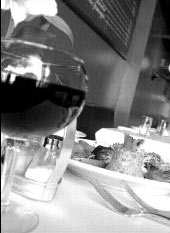FIGARO BISTRO 11 Roy, 284-6465 dinner 5-10 p.m., closed Mon.
Of all the revolutions the world has ever seen, food lovers should most appreciate the one that began on July 14, 1789. Along with freeing a handful of prisoners and beheading a few boring Catholic monarchs, it gave us the glory known as the restaurant industry. Before “libert鼯I>, 駡lit鼯I>, fraternit鼯I>,” good chefs were a private matter; haute cuisine was developed at the behest of delicate royal palates and court fashion, refined as queens brought their chefs with them to foreign lands, and improved by government-funded explorations that procured necessities such as chocolate, coffee, and peppercorns. But after that pesky little Reign of Terror episode, anyone with a pocketful of francs could belly up to the table and dine like a king. What could possibly have been more liberating for the middle class than to eat the same mussel dish formerly prepared for the dauphine?
Fast-forward 213 years and a few weeks to Lower Queen Anne—specifically, Figaro Bistro. This parking-garage-turned-failed-fake-’50s-diner-turned-polished-French-restaurant has risen gloriously from its humble automotive past to become a glossy tricolored treat—offering our own liberated middle class an excellent meal, impeccable service (including the special little crumb-scraping device), and dishes that any dauphine would find quite satisfying. The bistro’s recent face-lift includes a liberty-blue ceiling (with a funky multitude of descending pipes), deep red walls, crisp white linen, and a giant painting of those oh-so-symbolic tricolor beauties waving past a block of appropriately demure gray stone buildings. A string of those damned icicle lights should be hauled to the chopping block, but align your seat toward the windows and everything in the atmosphere will be simply merveilleux.
Allons-y, mes amis, to the food. The soups are gorgeous enough to merit eating in 85-degree weather; gratin饠ࠬ’oignon ($6) demonstrates once again that stock is of primary importance. Yes, the cheese, the toast, the delicate slivers of tender onion (all magically the same size), yes, these are lovely—but oh, the meaty lusciousness of the stock. It soothes. It lingers. It makes you slurp with joy. The soup du jour ($7) was a carrot-ginger (on at least two jours) and was equally marvelous, in a sublimely balanced way. The creamy carrots threaten to get frighteningly sweet, then Super Ginger swoops in and carries your taste buds off on a honeymoon. It teases. It kicks. It is exceptionally, gloriously, rich.
In comparison, the salads are nothing special—even in 85-degree weather. During a week when every chain grocery is overflowing with the plump red breasts of seasonal tomatoes, the crotin de ch趲e ($9) featured pale, nearly anemic, chunks of underripe tomato bathed in an oil fragrant with herbes de Provence. The satin-smooth, tangy cheese was flat-out delicious, but needed—craved—a fat and saucy cancan dancer of a tomato to live up to its promise. Figaro salad ($6) is exactly what it promised to be—”mixed greens tossed in a vinaigrette.” Herby, crunchy, and cool, a faint glimmer of, perhaps, mustard, but nothing likely to excite the populace.
Entr饳 were, across the board, magnifique. The ravioli ($15) was the most surprising, with a salty, earthy, meat-based sauce laden with c谥 mushrooms over sturdy dumplings. While not the delicate, toothsome pasta expected, the chewiness was exactly what was needed to complement such a complex topping. The fish special ($22) was halibut cheeks in a light cream sauce, with tiny green beans and smoothly pureed potatoes. Rich and meltingly tender, this dish was supremely elegant comfort food, if a tad light on the portion size for the price. Steak frites—a rib-eye with Roquefort butter and a huge pile of crispy fries—was a delight. Plain, the steak was flavorful and cooked perfectly; topped with Roquefort butter, it was a meat-lover’s triglyceride dream come true. Eat the fries as quickly as possible, as not only will your companions make off with them, but they are most crisp when they are still lavalike in temperature.
The wine list is simple and lovely, roaming the world rather than sticking with French choices, and several by-the-glass options are available. Of two desserts sampled, one was a bit disappointing—a cr譥 brl饠($6) on the firm and mealy rather than creamy side, with an odd accompaniment of whipped cream and strawberries. Profiteroles ($7), au contraire, were outstanding, swimming in a thin extra-bitter chocolate sauce with whipped cream that was divine with the fudge. Whichever dessert you choose, order coffee; the cool butterfat goodness of French desserts seems designed to go with that dark, bitter heat, and both ascend to higher levels of sweet-tooth satisfaction.
As with all establishments on Lower Queen Anne, you’ll be asked if you are heading to a show after your meal—if this is not the case, expect to have plenty of time for chatting and examining the funky ceiling pipes. But if you’re in a bit of a rush to make that opening curtain/starting bell, you’ll be whisked through with American-style speediness. Vive la r鶯lution!









